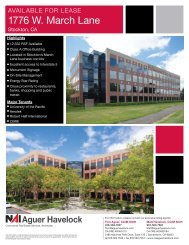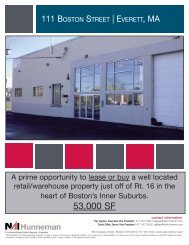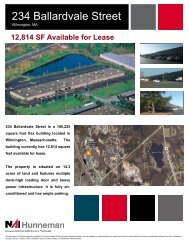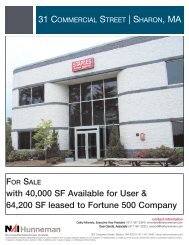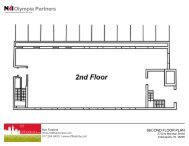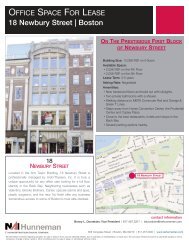2012 Global Market report - NAI Global
2012 Global Market report - NAI Global
2012 Global Market report - NAI Global
You also want an ePaper? Increase the reach of your titles
YUMPU automatically turns print PDFs into web optimized ePapers that Google loves.
Brazil. Brazil has proven to be one of the world’s most active economies, experiencing<br />
a growth rate of about 5% in 2011. The expectations of a continued economic boom<br />
can be attributed to the country’s large offshore oil deposits, strong and growing domestic<br />
consumption, Brazil’s hosting of the World Cup in 2014 and of the Olympics in 2016<br />
(causing public investment in infrastructure projects), alternative energy sources (e.g.,<br />
ethanol) and continued policy and bureaucratic reforms. In the short term, high business<br />
loan rates and bureaucracy will limit the country’s growth, but risk perception among<br />
international investors is declining. The Brazilian real continues to strengthen against the<br />
US dollar, from its low of 2.16 in late 2008 to 1.75 in late 2011.<br />
During 2011, the Brazilian real estate market grew at a faster pace than 2010. The<br />
country remains an attractive target for Greenfield Class A office, retail and particularly<br />
industrial development and speculative real estate acquisition. Lease rates for all product<br />
types increased while cap rates hover between 9-11%.<br />
Colombia. Colombia was finally granted free trade status with the US, which will further<br />
benefit the economy. Several sectors including agriculture, retail, services and BPO will<br />
gain the most. Over the last 15 years, the country has steadily grown and improved its<br />
democratic credentials, and the peso has been relatively stable, with a government target<br />
of about 1,800 COP to the dollar.<br />
Both real estate development and pricing were relatively strong in 2011, with demand<br />
exceeding supply. International investment funds have yet to venture strongly into<br />
Colombia, but the domestic capital sources are investing actively in Greenfield projects<br />
and are fueling development growth. Given the lack of a transparent investment market<br />
for existing product and a shortage of investment sales, cap rates are difficult to identify,<br />
but are estimated to be 12% or greater.<br />
Chile. Chile continues to serve as a benchmark for most emerging economies in the region<br />
as the Chilean economy recorded another respectable year of growth. Inflation was stable,<br />
while the 7% unemployment rate is among the lowest in Latin America. The recovering<br />
prices for copper and other commodities, paired with an increase in global demand, helped<br />
the Chilean economy prosper in 2011. Continued attempts to decrease dependence on<br />
imports of natural gas, by developing hydroelectric projects in the Andes, has been hindered<br />
by ecological challenges. Therefore, Chile is currently building its first LNG terminal to secure<br />
a supply for existing and upcoming gas-fired thermal plants, and has engaged in the<br />
construction of several new hydropower and coal-fired thermal plants. Chilean companies,<br />
profiting from their strong domestic economy, have moved from the cautious international<br />
expansion mode to an aggressive one. Their targets are primarily Peru, Colombia,<br />
Argentina, and Brazil, with Costa Rica, Panama and the US also recently added to the list.<br />
Demand for quality commercial real estate continued to be strong, with vacancies remaining<br />
below 3%. Rental rates remained stable, with cap rates at about 8-10%.<br />
Costa Rica. The market is now stable and almost fully recovered from the global financial<br />
crisis. Demand is increasing and existing supply is being absorbed. Developments that<br />
were on hold are now proceeding to construction. Real estate activity was strong during<br />
2011 with resort, hotel, and second home sectors on the Pacific Coast still awaiting a<br />
rebound. In the municipal area of San José, leasing and sale activity increased in the office<br />
and industrial sectors, and rental rates were stable. The retail sector showed a stronger<br />
recovery in demand, with upward pressure on shopping malls and High Street rents.<br />
<strong>2012</strong> <strong>Global</strong> <strong>Market</strong> Report n www.naiglobal.com<br />
21



